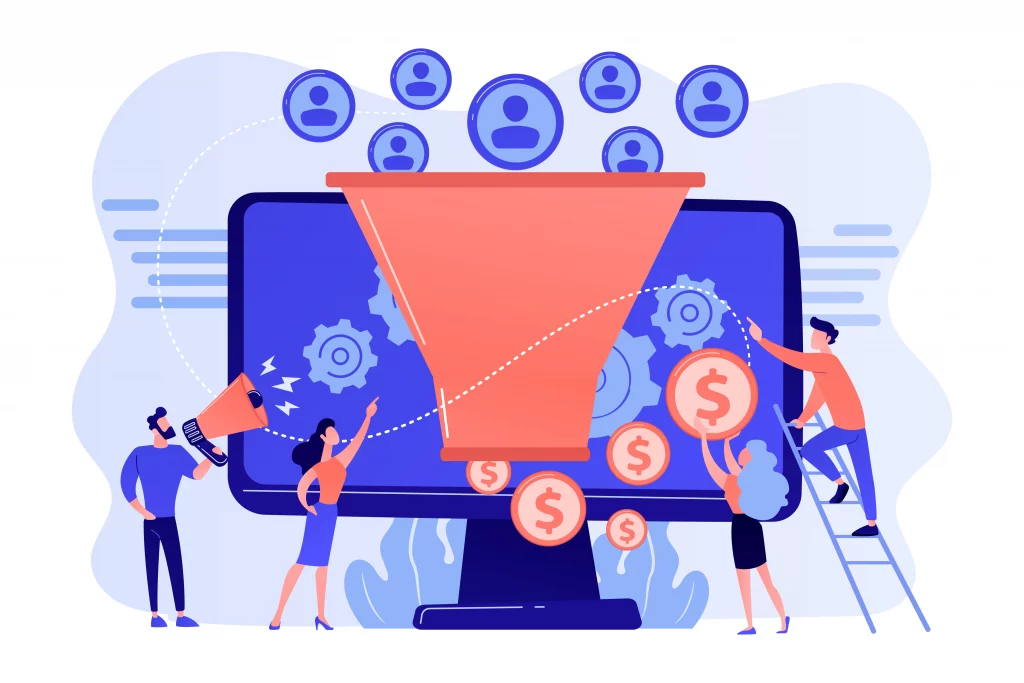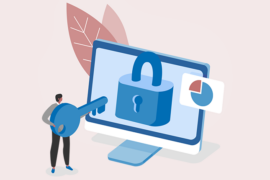Imagine you’re walking down a busy street, and you see a sign that says “Free Ice Cream”. You’re curious, so you follow the sign to a small shop. There, you find a friendly staff member who hands you a delicious scoop of ice cream. You enjoy it, and then you notice that there are more flavors available for purchase. You decide to buy another scoop, and then you see that they also sell toppings, cones, and other treats. Even though you spent more money than you had anticipated, you are pleased with your purchase. You leave the shop, and you tell your friends about it.
What just happened? You went through a sales funnel.
A sales funnel is a powerful tool for understanding and optimizing your customers’ journey from awareness to purchase. In this blog, you will learn what a sales funnel is, why it is important, and how to create one for your business.
You will discover:
- How a sales funnel can help you attract, engage, and convert more prospects into customers.
- How to define your target audience and buyer persona, and map out your customer journey.
- How to design your sales funnel stages, and align them with your marketing and sales activities.
- How to test and optimize your sales funnel, and measure your conversion rates, revenue, and return on investment.
By the end of this blog, you will be able to create a sales funnel that works for you, and that helps you grow your business. Ready to get started? Let’s dive in.
What is a Sales Funnel?
A sales funnel is a visualization of the steps that potential customers take before buying your product or service. It shows how many people move from one stage to the next, and where they drop off or convert. A typical sales funnel has six stages:
- Awareness: This is when prospects become aware of your brand, product, or service through various channels, such as ads, social media, or referrals.
- Interest: This is when prospects show interest in your offer by signing up for your email list, following you on social media, or visiting your website.
- Consideration: This is when prospects evaluate your offer and compare it with other options. They may read reviews, watch demos, or request a quote.
- Intent: This is when prospects indicate their intention to buy your product or service. They may add it to their cart, fill out a form, or contact you directly.
- Purchase: This is when prospects become customers by completing the transaction and paying for your product or service.
- Loyalty: This is when customers become loyal fans of your brand, product, or service. They may buy from you again, refer others, or leave positive feedback.
Understanding your customers’ needs, problems, and driving forces at every turn of their journey is made easier with the aid of a sales funnel. It also helps you identify and eliminate gaps, bottlenecks, and friction points that prevent prospects from moving forward. Additionally, it helps you optimize and personalize your marketing and sales strategies to attract, engage, and convert more prospects into customers. Finally, it helps you measure and improve your conversion rates, revenue, and return on investment.
Why is a sales funnel important?
The following are some benefits of having a sales funnel:
- Understand your customers’ needs, pain points, and motivations at each stage of their journey.
- Identify and eliminate gaps, bottlenecks, and friction points that prevent prospects from moving forward.
- Optimize and personalize your marketing and sales strategies to attract, engage, and convert more prospects into customers.
- Measure and improve your conversion rates, revenue, and return on investment.
A sales funnel can help you understand how customers weigh the pros and cons of purchasing. It also helps you visualize the different steps for your team to cater to. It can help you identify holes in the sales journey and give you a chance to attend to them. A sales funnel also helps you keep your prospects on track, on pace, and target for a big-win finish.
How to build your company’s sales funnel
Creating a sales funnel for your business involves four steps:
- Define your target audience and buyer persona. This is the profile of your ideal customer, based on their demographics, psychographics, behavior, and goals. You can use tools like surveys, interviews, or analytics to collect and analyze data about your existing and potential customers.
- Map out your customer journey. This is the path that your customers take from awareness to purchase, and beyond. You can use tools like Google Analytics, customer surveys, and feedback forms to understand how your customers find you, interact with you, and buy from you.
- Design your sales funnel stages. This is where you align your marketing and sales activities with your customer journey. You can use tools like Salesforce, Shopify, or Mailchimp to create landing pages, email campaigns, webinars, and other touchpoints that guide your prospects through your funnel .
- Test and optimize your sales funnel. This is where you monitor and analyze your funnel performance, and make adjustments as needed. You can use tools like Google Optimize, Hotjar, or Optimizely to run A/B tests, track conversions, and optimize your funnel for maximum results.
How a sales funnel can help you attract, engage, and convert more prospects into customers
A sales funnel can help you attract, engage, and convert more prospects into customers by:
- Helping you understand your customers’ needs, pain points, and motivations at each stage of their journey.
- Assisting you in locating and removing obstacles, bottlenecks, and points of friction that keep potential customers from moving forward.
- Helping you optimize and personalize your marketing and sales strategies to match your customers’ preferences and expectations.
- Helping you measure and improve your conversion rates, revenue, and return on investment.
How to define your target audience and buyer persona, and map out your customer journey
To define your target audience and buyer persona, and map out your customer journey, you need to:
- Collect and analyze data about your existing and potential customers, such as their demographics, psychographics, behavior, and goals. You can use tools like surveys, interviews, or analytics to do this.
- Create a profile of your ideal customer, based on the data you collected. This is your buyer persona, and it should include details like their name, age, gender, occupation, income, challenges, needs, desires, and motivations.
- Create a visualization of the path that your customers take from awareness to purchase, and beyond. This is your customer journey, and it should include the stages, actions, emotions, and touchpoints that your customers experience along the way.
How to design the stages of your sales funnel and match them to your marketing and sales initiatives.
To design your sales funnel stages, and align them with your marketing and sales activities, you need to:
- Define the goals and metrics for each stage of your sales funnel, such as the number of leads, conversions, sales, and retention.
- Create and implement marketing and sales activities that correspond to each stage of your sales funnel, such as landing pages, email campaigns, webinars, and follow-ups. You can use tools like Salesforce, Shopify, or Mailchimp to do this.
- Ensure that your marketing and sales activities are consistent, relevant, and valuable for your customers, and that they guide them smoothly and persuasively through your sales funnel.
How to test and optimize your sales funnel, and measure your conversion rates, revenue, and return on investment.
To test and optimize your sales funnel, and measure your conversion rates, revenue, and return on investment, you need to:
- Monitor and analyze your sales funnel performance, using tools like Google Analytics, Google Optimize, Hotjar, or Optimizely. You should track metrics like traffic, bounce rate, time on page, click-through rate, conversion rate, average order value, customer lifetime value, and return on investment.
- Run A/B tests, experiments, and surveys to identify and improve the elements that affect your sales funnel performance, such as headlines, images, copy, layout, design, offer, and call to action.
- Make data-driven decisions and adjustments to your sales funnel, based on the results of your tests and analysis. You should also keep testing and optimizing your sales funnel on a regular basis, to ensure that it is always up to date and effective.
Sales funnel example
To illustrate how a sales funnel works, let’s look at an example of a B2C sales funnel for an online course platform.
- Awareness: The platform runs Facebook ads and YouTube videos to target people who are interested in learning new skills online.
- Interest: The platform offers a free trial and a lead magnet (e.g., a cheat sheet, a checklist, or a mini-course) to capture the email addresses of the prospects who click on the ads or videos.
- Consideration: The platform sends a series of email newsletters and blog posts to educate the prospects about the benefits and features of the online courses, and to showcase success stories and testimonials from previous students.
- Intent: The platform invites the prospects to a live webinar, where they can see a demo of the online courses, ask questions, and get a special discount code.
- Purchase: The platform follows up with the prospects who attended the webinar, and reminds them of the discount code and the deadline to enroll in the online courses.
- Loyalty: The platform provides ongoing support and access to a community of students and instructors, and encourages the customers to share their feedback, referrals, and reviews.
Here is another example of a sales funnel for a B2B software company:
- Awareness: The company runs online ads and social media posts to target businesses that are looking for a software solution to their problem. They also create blog posts, ebooks, and videos to educate their audience about the problem and the solution.
- Interest: The company offers a free trial and a lead magnet (e.g., a case study, a white paper, or a checklist) to capture the email addresses of the prospects who click on the ads or content. They also use SEO and PPC to drive organic and paid traffic to their website.
- Consideration: The company sends a series of email newsletters and webinars to nurture the prospects and demonstrate the value and features of their software. They also showcase customer testimonials and reviews to build trust and credibility.
- Intent: The company invites the prospects to a free consultation, where they can ask questions, see a demo, and get a personalized quote. They also use retargeting ads and follow-up emails to remind the prospects of the benefits and urgency of their offer.
- Purchase: The company closes the deal by sending a contract and an invoice to the prospects who agreed to the consultation. They also use discounts, guarantees, and referrals to incentivize the prospects to sign up and pay for the software.
- Loyalty: The company provides ongoing support and training to the customers and ensures their satisfaction and retention. They also encourage the customers to share their feedback, referrals, and reviews.
Conclusion
A sales funnel is a powerful tool for understanding and optimizing your customers’ journey from awareness to purchase. By creating a sales funnel that matches your customers’ needs, pain points, and motivations, you can increase your conversions, revenue, and customer loyalty.
In this blog post, you learned how to create a sales funnel for your business, by following these steps:
- Define your target audience and buyer persona, and map out your customer journey.
- Design your sales funnel stages, and align them with your marketing and sales activities.
- Test and optimize your sales funnel, and measure your conversion rates, revenue, and return on investment.
By following these steps, you can create a sales funnel that works for you, and that helps you grow your business. If you need help with building a sales funnel for your business, you can leave a comment below.
I appreciate you taking the time to read this blog, and I hope you found it helpful. And don’t forget to share this blog with your friends and colleagues who might benefit from it. Happy funneling!





